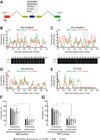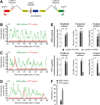Enhancer Control of Transcriptional Bursting
- PMID: 27293191
- PMCID: PMC4970759
- DOI: 10.1016/j.cell.2016.05.025
Enhancer Control of Transcriptional Bursting
Abstract
Transcription is episodic, consisting of a series of discontinuous bursts. Using live-imaging methods and quantitative analysis, we examine transcriptional bursting in living Drosophila embryos. Different developmental enhancers positioned downstream of synthetic reporter genes produce transcriptional bursts with similar amplitudes and duration but generate very different bursting frequencies, with strong enhancers producing more bursts than weak enhancers. Insertion of an insulator reduces the number of bursts and the corresponding level of gene expression, suggesting that enhancer regulation of bursting frequency is a key parameter of gene control in development. We also show that linked reporter genes exhibit coordinated bursting profiles when regulated by a shared enhancer, challenging conventional models of enhancer-promoter looping.
Copyright © 2016 Elsevier Inc. All rights reserved.
Figures







Comment in
-
Gene Regulation: Activation through Space.Curr Biol. 2016 Oct 10;26(19):R895-R898. doi: 10.1016/j.cub.2016.08.031. Epub 2016 Oct 10. Curr Biol. 2016. PMID: 27728794
References
Publication types
MeSH terms
Substances
Grants and funding
LinkOut - more resources
Full Text Sources
Other Literature Sources
Molecular Biology Databases

